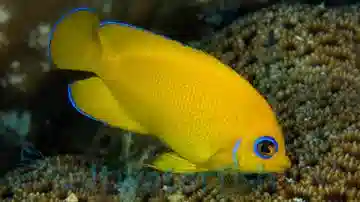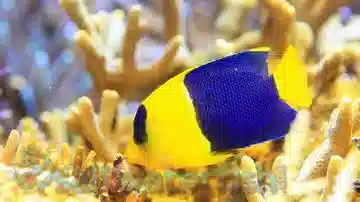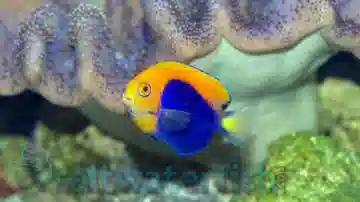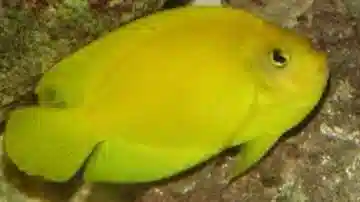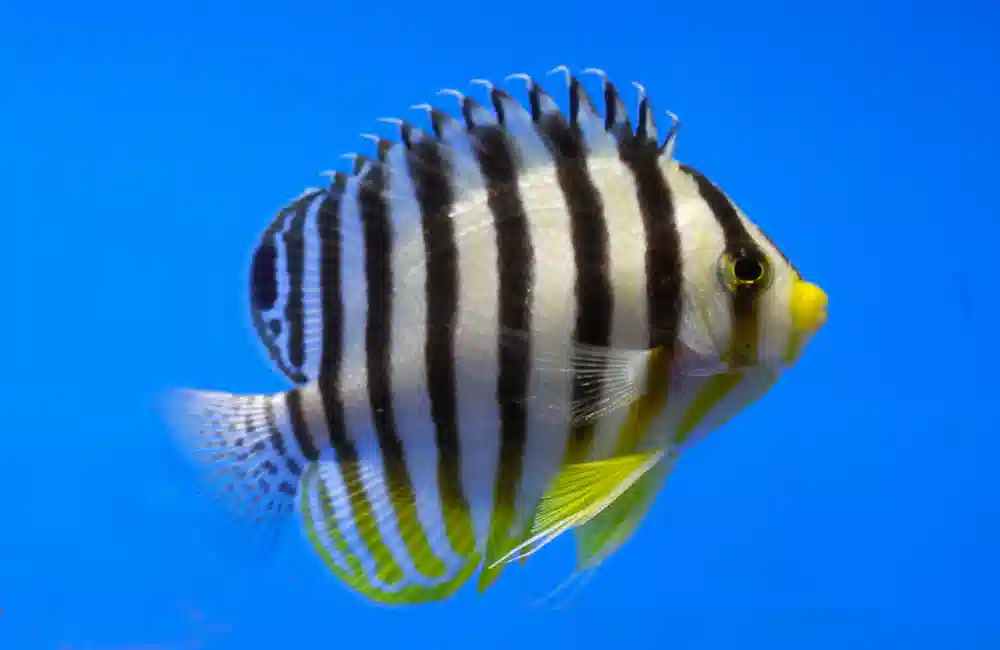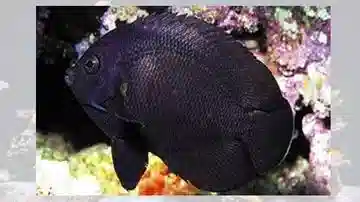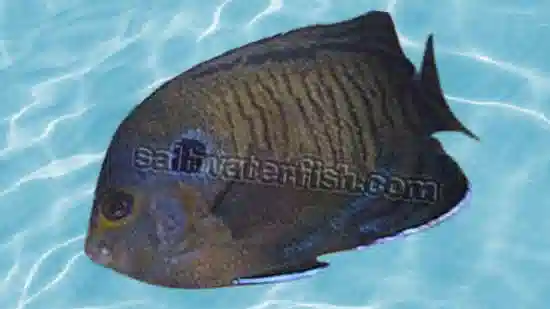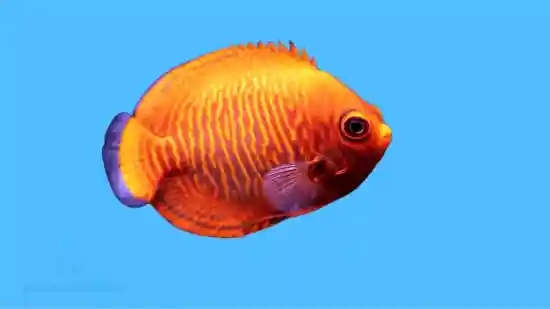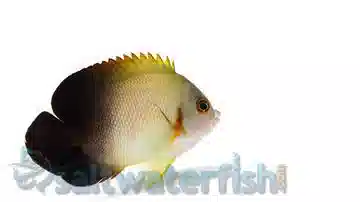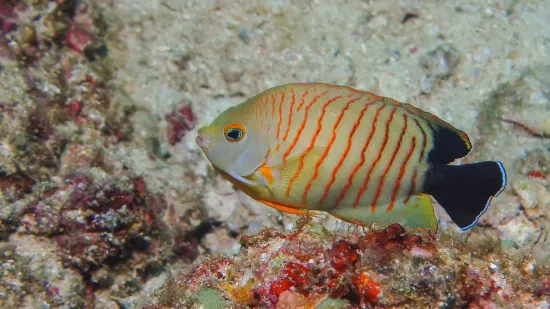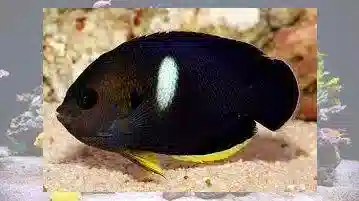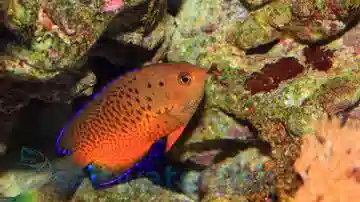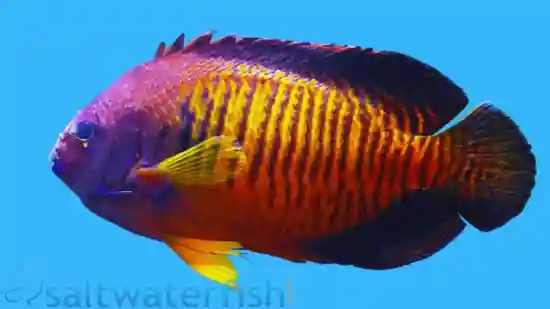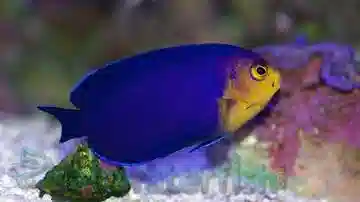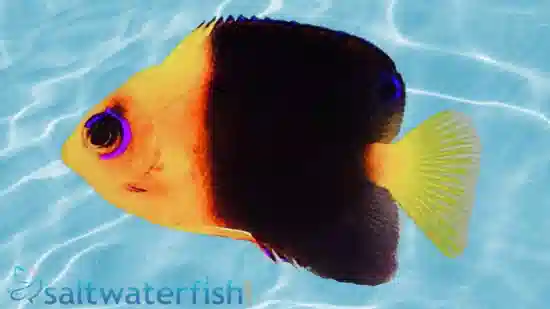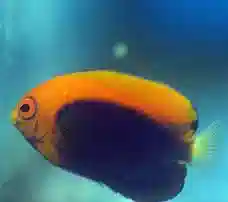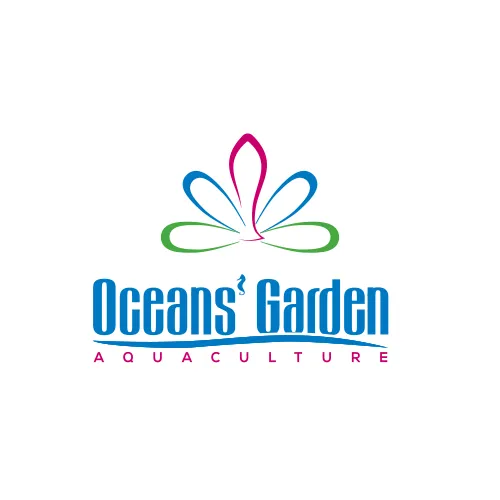Dwarf Angelfish In Saltwater Aquariums: FAQ
Saltwater angelfish are prized for their bold colors and regal presence, but they fall into two broad categories: dwarf (pygmy) angelfish and large angelfish. While both are stunning additions, their size, care needs, and reef compatibility differ significantly.
*Dwarf Angelfish (Genus Centropyge):
Size: Usually 3–5 inches fully grown.
Tank requirements: Thrive in smaller aquariums (minimum 55–70 gallons).
Reef safety: Many species, like the Coral Beauty Angelfish, are considered “reef-safe with caution.” They may nip at coral polyps or clam mantles, but most do well in established reefs with ample algae and live rock.
Behavior: Generally hardy and adaptable, making them popular with intermediate aquarists.
Examples: Flame Angelfish, Coral Beauty, Lemonpeel, and Potter’s Angelfish.
*Large Angelfish (Genera Pomacanthus & Holacanthus):
Size: Can reach 10–15 inches (some even larger).
Tank requirements: Require much larger systems (minimum 180 gallons, 6 ft+ tanks).
Reef safety: Most large angels are not reef-safe. They are known to nip at LPS and SPS corals, clams, and sponges, which make up much of their natural diet.
Behavior: Majestic and commanding, but more demanding in terms of space, diet, and water quality stability.
Examples: Emperor Angelfish, Queen Angelfish, and Blueface Angelfish.
Bottom line: Choose dwarf angels if you want manageable size and potential reef compatibility, or large angels if you have a spacious fish-only system and want a true showpiece. Browse our full range of dwarf and large angelfish today, each backed by our 8-Day Live Guarantee.
Dwarf angelfish (Centropyge species) are hardy, long-lived fish when cared for properly. In a home aquarium, most dwarf angelfish live 5–7 years, though many hobbyists report lifespans of up to 10 years in well-maintained reef systems. In the wild, some species can live even longer due to stable conditions and natural food sources.
Factors that influence dwarf angelfish lifespan:
Tank size & stability: A minimum of 55–70 gallons is recommended for most species, with stable salinity (1.024–1.026) and pH (8.1–8.4).
Diet: Dwarf angels thrive on a mix of marine algae, spirulina, mysis shrimp, and high-quality pellets. Algae-rich live rock promotes natural grazing behavior.
Tank mates: Peaceful companions reduce stress. Aggression from larger fish can shorten lifespans.
Reef setup: While many are “reef-safe with caution,” providing ample live rock for grazing helps keep them healthy and engaged.
Thresher & Brothers (1985) found that dwarf angelfish such as Centropyge bispinosa can live for a decade or more in the wild, with longevity strongly linked to habitat quality and food availability.
One Coral Beauty Angelfish reviewer wrote: “This coral Beauty is The most beautiful healthy and hardy Dwarf Angelfish I have ever seen.” — Saltwaterfish.com Customer Review.
Examples of popular dwarf angels and typical lifespans:
Coral Beauty Angelfish (Centropyge bispinosa) – 7–10 years in captivity.
Flame Angelfish (Centropyge loricula) – 5–7 years with proper diet and space.
Lemonpeel Angelfish (Centropyge flavissima*) – 6–8 years, but requires careful reef management.
Bottom line: With proper tank size, diet, and stable conditions, dwarf angelfish can live close to a decade in your aquarium. Explore our selection of dwarf angelfish today, each backed by our 8-Day Live Guarantee for confidence.
Dwarf angelfish (Centropyge species) are smaller than their large angelfish cousins, but they still need space to grow and thrive. Most dwarf angels reach 3–5 inches in length at full maturity, though a few species can grow larger.
Typical size ranges of popular dwarf angels:
Coral Beauty Angelfish (Centropyge bispinosa) – Usually 4 inches, occasionally up to 5 inches.
Flame Angelfish (Centropyge loricula) – 4 inches, with bright red-orange body and black bars.
Lemonpeel Angelfish (Centropyge flavissima) – Reaches about 5 inches, one of the larger dwarfs.
Potter’s Angelfish (Centropyge potteri) – 4 inches, prized for its intricate blue and orange patterns.
Cherubfish or Pygmy Angelfish (Centropyge argi) – One of the smallest, typically only 2–3 inches, making it popular for nano setups.
Environmental conditions strongly affect growth. In stable, well-fed aquariums, dwarf angels reach their full adult size, while cramped tanks or poor diets can stunt development. Field studies confirm that most Centropyge plateau at 3–5", with growth rates tied to habitat quality and food availability (Thresher & Brothers, 1985).
One Pygmy Angelfish reviewer wrote: “A cute, little, lively fish that brings a lot of character to your tank. Seems to play well with others and makes a welcome addition while being an easy keeper.” — Saltwaterfish.com Customer Review.
Pro Tips for supporting healthy growth:
Provide at least 55–70 gallons for most dwarf angels; even smaller species benefit from space.
Feed a varied diet of algae, spirulina, mysis shrimp, and pellets to promote vibrant color and growth.
Offer ample live rock for natural grazing and shelter.
Bottom line: Dwarf angelfish typically max out around 3–5 inches, making them compact yet striking additions to a reef tank. Choose your favorite dwarf angelfish today and enjoy a manageable, colorful centerpiece, backed by our 8-Day Live Guarantee.
Dwarf angelfish (Centropyge species) are beloved for their vibrant colors and manageable size, but reef keepers often ask: are they truly “reef-safe”? The answer is nuanced.
What they eat in the wild:
Studies of Centropyge diets show that they graze primarily on algae, detritus, sponges, and tunicates (Hourigan et al., 1989). This explains their constant picking behavior on reef surfaces and live rock.
In aquariums:
That same grazing instinct sometimes leads them to nip at coral polyps, especially fleshy LPS corals (like acans and brains), soft corals, or clam mantles. Some individuals never bother corals, while others may repeatedly pick until damage occurs.
That said, countless aquarists successfully keep dwarf angels in reef tanks without major coral loss. Popular species like the Coral Beauty Angelfish and Flame Angelfish are considered “reef-compatible with caution.” Success often depends on the individual fish, tank size, and providing ample natural grazing surfaces. A well-fed angel (offered spirulina, mysis, and high-quality angelfish preparations) will be less likely to nip corals out of hunger or boredom.
Pro tips for minimizing coral risk:
Choose larger reef tanks (70+ gallons) with lots of live rock for grazing.
Keep your angel well-fed with varied foods.
- Monitor closely at first. If excessive nipping occurs, relocation may be necessary.
Bottom line: Dwarf angelfish are not 100% reef-safe, but many hobbyists keep them successfully with corals and invertebrates. With the right preparation and feeding routine, you can enjoy their dazzling colors without sacrificing coral health. Browse our collection today and find your perfect dwarf angel, backed by our trusted guarantee.
When choosing the best dwarf angelfish (Centropyge species) for a reef tank, the key is balancing beauty with coral compatibility. Dwarf angels are among the most colorful marine fish, but not all are equally suited for reef environments. Most are considered “reef safe with caution” meaning they may nip at corals or clam mantles, but many hobbyists keep them successfully.
Top choices for reef tanks include:
Coral Beauty Angelfish – Hardy, adaptable, and one of the most widely kept dwarf angels. With abundant live rock, they often leave corals alone.
Flame Angelfish – Striking red-orange body with black bars; reef safe in many cases if well-fed.
Potter’s Angelfish – A Hawaiian native with intricate orange-and-blue patterning. Best for experienced keepers, but rewarding in larger reef tanks.
Cherub (Pygmy) Angelfish – One of the smallest dwarfs at 2–3 inches, popular for nano reef setups
Pro tips for reef compatibility:
Provide ample live rock for grazing.
Use tanks 55 gallons or larger for most species.
- Monitor coral interaction during the first few weeks.
Bottom line: The best dwarf angelfish for reef tanks are Coral Beauty, Flame, Potter’s, and Cherub angels. With proper tank size, nutrition, and close observation, they can be stunning, reef-compatible additions. Explore our selection today, backed by our 8-Day Live Guarantee for peace of mind.
Dwarf angelfish (Centropyge species) thrive on a varied, omnivorous diet that replicates their natural feeding habits in the wild. On the reef, they graze constantly on microalgae, sponges, and detritus, occasionally sampling soft coral polyps. In a home aquarium, the goal is to provide a rich blend of algae-based foods and meaty supplements to keep them healthy, colorful, and less likely to nip corals.
Hourigan et al. (1989) found that angelfish diets are heavily based on algae and sponges in natural reefs, explaining why prepared foods with sponge content are especially effective in aquaria. In aquariums, supplementing with nori sheets clipped to rocks can mimic their constant grazing behavior and keep them active.
Staple foods for dwarf angels:
Marine algae & spirulina – Vital for digestion, immunity, and vibrant coloration.
Frozen mysis shrimp & brine shrimp – Offer protein for growth and energy.
Angelfish-specific preparations – Many contain sponge material, replicating their natural diet.
High-quality pellets or flakes – Choose brands designed for omnivorous marine fish.
Pro feeding tips:
Offer 2–3 small meals daily rather than one large feeding.
Mix algae-based and protein-rich foods to cover all needs.
- Encourage natural grazing with live rock and macroalgae.
Bottom line: The best food for dwarf angelfish is a balanced mix of algae, sponges, and protein sources. With the right diet, they’ll show brighter colors, live longer, and remain peaceful tankmates. Stock up on premium angelfish food along with your new dwarf angel, and enjoy their beauty with confidence.
Acclimating a dwarf angelfish (Centropyge species) correctly is one of the most important steps for long-term success. These fish are hardy once established, but sudden changes in water chemistry or stress during introduction can lead to illness or shortened lifespan.
Step-by-step acclimation for dwarf angels:
1. Float the sealed bag in your tank for 15–20 minutes to equalize temperature.
2. Open the bag and place the fish (and shipping water) into a clean bucket.
3. Using airline tubing, set up a siphon drip from your tank into the bucket at 2–4 drops per second.
4. Let the process run for 1–2 hours until the water volume doubles.
5. Net the angelfish and gently place it into your tank, never add shipping water.
Scientific reviews confirm that gradual acclimation reduces stress and mortality in marine ornamentals. Moorhead & Zeng (2010) found that drip methods allow fish to adjust physiologically to new salinity and chemistry, improving survival in the first critical week.
One Pygmy Angelfish reviewer wrote: “I bought this little guy here and to show you how hardy this guy is, he was the most active of 5 fish I had delivered when outside temp in MN was 21 degree out and bag water was at 68 degrees. All survived after 2 1/2 hr slow drip acclimation. He is a colorful little guy to watch darting around the tank.” — Saltwaterfish.com Customer Review.
Pro tips: Dim your lights during introduction, provide plenty of hiding spaces, and avoid adding aggressive tankmates at the same time.
Bottom line: Proper acclimation, especially drip acclimation, sets your dwarf angelfish up for a healthy, stress-free transition. Pair our 8-Day Live Guarantee with careful acclimation steps, and you’ll enjoy your angelfish’s color and personality for years to come.
Dwarf angelfish (Centropyge species) are active, colorful fish that add constant motion to a saltwater aquarium. In community tanks, they are best described as semi-aggressive, not outright bullies, but territorial enough to hold their ground. Their behavior depends on tank size, tank mates, and the specific angelfish species.
In larger reef aquariums (55 gallons or more), most dwarf angels coexist peacefully with clownfish, gobies, tangs, wrasses, and other non-aggressive species. They spend much of their time grazing on live rock, darting in and out of caves, and patrolling a preferred section of the tank. In smaller setups, however, they may become territorial, especially toward other angelfish or fish with similar shapes and diets.
Some species are more assertive than others. Coral Beauty Angelfish and Flame Angelfish are among the most community-friendly. By contrast, Lemonpeel and Half-Black Angels may show stronger territorial behavior. Introducing them into a well-structured tank with plenty of hiding spots and live rock helps minimize conflict.
One Coral Beauty Angelfish reviewer wrote: “love this fish\! Pictures don't compare to the real thing. It is a very peaceful fish that is full of character. Everyone loves it.” — Saltwaterfish.com Customer Review.
Pro tips:
Keep one dwarf angelfish per tank unless the aquarium is very large (100+ gallons).
Introduce them later in the stocking order, once other fish have established territories.
- Feed a varied diet to reduce competition over food.
Bottom line: Dwarf angelfish are lively, semi-aggressive fish that generally thrive in community tanks when given space and structure. With the right setup, they’ll add color and character to your aquarium, backed by Saltwaterfish.com’s 8-Day Live Guarantee.
Dwarf angelfish (Centropyge species) are among the most popular saltwater fish because they combine vibrant color with a manageable size. But not all species are equally suited for new aquarists. Some are hardier and more adaptable, while others require advanced care. Choosing the right beginner-friendly dwarf angel ensures a smoother experience and a healthier, longer-lived fish.
Top beginner dwarf angelfish:
Coral Beauty Angelfish – Considered the hardiest dwarf angel. Thrives in a variety of tank setups, accepts many foods, and adapts quickly.
Flame Angelfish – Striking red-orange body and black bars. Generally hardy, though slightly more sensitive than Coral Beauty.
Cherub (Pygmy) Angelfish – Tiny (2–3 inches), making it suitable for smaller reef tanks. Active and tough for its size.
Half-Black Angelfish – Affordable and relatively resilient, though a bit more territorial in compact tanks.
These species are considered beginner-friendly because they:
Adapt well to prepared foods (algae, spirulina, mysis).
Handle minor fluctuations in water quality better than delicate species like Potter’s or Multicolor Angelfish.
- Acclimate quickly when drip acclimation is followed.
Scientific reviews of the ornamental fish trade note that species with wide geographic ranges and generalist diets, like Coral Beauty and Flame Angels, survive better in captivity than more specialized species such as Potter’s (C. potteri) (Wabnitz et al., 2003).
One Flame Angelfish reviewer wrote: “We love our Flame Angelfish. We have had him for about four months now, and he is doing super. His colors are so florescent, you can see him from across our office. Our employees and customers always remark on how striking he is. He gets along with all of his tank mates, and readily takes flake food, algae tablets and frozen mysis and spirulina cubes. We love him\!” — Saltwaterfish.com Customer Review.
Dwarf angelfish (Centropyge species) are some of the most sought-after saltwater fish thanks to their dazzling colors, compact size, and lively personalities. While dozens of species exist, a handful stand out as the most popular choices for marine aquariums due to their availability, beauty, and adaptability.
Top dwarf angelfish species in home aquariums:
Coral Beauty Angelfish – Known for its purple-and-orange coloration and hardiness, this species is considered the \#1 choice for beginners and experts alike.
Flame Angelfish – A vibrant red-orange showpiece with vertical black bars, often regarded as one of the most stunning marine fish available.
Potter’s Angelfish – Native to Hawaii, famous for its intricate orange-and-blue patterning; more challenging but highly prized.
Cherub (Pygmy) Angelfish – At 2–3", it’s one of the smallest species. Hardy and feisty, suited for smaller reef aquariums (\~30+ gallons).
Lemonpeel Angelfish – Bright yellow with a bold blue ring around the eye, making it instantly recognizable.
Trade data confirm their popularity. Analyses of the marine ornamental fish industry show that Coral Beauty and Flame Angels consistently rank among the most collected and exported reef fish worldwide, reflecting their hardiness and broad appeal to hobbyists (Rhyne et al., 2012; Wabnitz et al., 2003).
One Saltwaterfish.com Lemonpeel Angelfish reviewer wrote: “Received in great shape and has added life to my saltwater aquarium. Thanks” — Saltwaterfish.com Customer Review.
Pro tips for popular species:
Provide at least 55 gallons for most dwarfs (larger for Potter’s or Lemonpeel).
Use live rock for grazing to mimic their natural behavior.
Keep one dwarf angelfish per tank unless you have 100+ gallons.
Bottom line: The most popular dwarf angelfish are Coral Beauty, Flame, Potter’s, Cherub, and Lemonpeel Angels. Their mix of color, personality, and adaptability makes them staples in marine aquariums worldwide. Explore our full collection and choose your favorite, backed by Saltwaterfish.com’s 8-Day Live Guarantee.
Dwarf angelfish (Centropyge species) are generally classified as semi-aggressive, but certain species are known to be far more community-friendly than others. For aquarists who want the beauty of a dwarf angel without excessive territorial disputes, choosing one of the more peaceful species makes a big difference.
Most peaceful dwarf angelfish for community tanks:
Coral Beauty Angelfish – Hardy, adaptable, and widely praised for being among the least aggressive Centropyge species.
Flame Angelfish – Vibrant and active, often peaceful when housed in 55+ gallon tanks with hiding spots.
Cherub (Pygmy) Angelfish – Despite its tiny size, it tends to coexist well in nano or community reef tanks if not crowded.
Half-Black Angelfish – Considered mellow compared to Lemonpeel or Bicolor Angels, especially when provided with grazing space.
Aggression in dwarf angels is strongly tied to environment. Larger tanks (55+ gallons for most species) with plenty of live rock and broken sightlines reduce competition. Studies of reef fish community ecology show that territorial aggression decreases when resources and shelter are abundant (Allen, 1998).
One Saltwaterfish.com Pygmy Angelfish reviewer wrote: “An awesome little beautiful fish who peacefully explores my large reef tank's caves. Almost always visible and active.” — Saltwaterfish.com Customer Review.
Pro tips for harmony:
Add dwarf angels later in the stocking order to reduce territorial claims.
Avoid housing two dwarf angels in the same tank unless it’s 100+ gallons.
- Feed a varied diet to reduce food competition.
Bottom line: The most peaceful dwarf angelfish are Coral Beauty, Flame, Cherub, and Half-Black Angels. With proper space and diet, they integrate beautifully into community or reef tanks. Shop your favorite today, backed by Saltwaterfish.com’s trusted 8-Day Live Guarantee.
Dwarf angelfish (Centropyge species) and clownfish are among the most popular saltwater fish for home aquariums and the good news is that they usually make excellent tankmates. Clownfish are hardy, semi-aggressive fish that tend to stick close to a host anemone or a favored rock, while dwarf angelfish are active grazers that spend their time picking at live rock and swimming throughout the aquarium. Because they occupy different niches, they rarely come into direct conflict.
That said, there are some considerations to keep in mind:
Tank size matters: A minimum of 55 gallons is recommended for most dwarf angels. In smaller tanks, territorial disputes are more likely.
Temperament varies by species: Coral Beauty Angelfish and Flame Angelfish are generally peaceful, while Potter’s or Lemonpeel angels may show more assertive behavior.
Clownfish personalities differ too: Ocellaris and Percula Clownfish are typically mellow, but Maroon Clowns can be territorial and may challenge other mid-sized fish, including dwarf angels.
Research on reef fish communities shows that species with different feeding and sheltering strategies coexist with minimal aggression, provided enough space and resources (Sale, 1991). This ecological principle carries over to the aquarium, where dwarf angels and clownfish usually share tanks successfully.
Pro tips:
Introduce both species at similar sizes to minimize bullying.
- Add the dwarf angel after the clownfish has settled in, as clowns usually adapt faster.
Provide hiding spots and rockwork to break line-of-sight if squabbles arise.
Bottom line: Yes, dwarf angelfish and clownfish generally get along well, especially in tanks with enough space and structure. Together, they create a lively, colorful reef display. Explore our collection today and shop with confidence, backed by Saltwaterfish.com’s 8-Day Live Guarantee.
Dwarf angelfish (Centropyge species) are prized for their color and personality, but they are also territorial. Keeping multiple dwarf angels together is possible, but it requires careful planning around tank size, species choice, and introduction order.
General rules for mixing dwarf angelfish:
Tank size: A single dwarf angel is best in aquariums under 70 gallons. To attempt multiples, plan for at least 70–90 gallons, with larger systems (120+ gallons) offering the highest success rates.
Species choice: Avoid mixing closely related species like Flame (C. loricula) and Coral Beauty (C. bispinosa), which often fight. Instead, consider combinations with different coloration and temperament (e.g., Coral Beauty with Cherubfish).
Pairs & harems: Some species, such as Cherub (C. argi) and African Flameback (C. acanthops), can be kept as bonded pairs or small harems if introduced together.
Introduction order: Add dwarf angels at the same time or place the less aggressive species first to prevent territorial dominance.
Aquascaping: Provide abundant live rock with multiple caves and territories to break line of sight.
Scientific studies of Centropyge show that aggression is strongly linked to space and social structure. In the wild, dwarf angelfish maintain small territories, but in larger reef habitats, pairs and harems establish hierarchies successfully (Thresher & Brothers, 1985).
One Saltwaterfish.com Potters Angelfish \- Hawaii reviewer wrote: “love this Potters Angelfish \- Hawaii \! Pictures don’t compare to the live fish. The new addition improves my saltwater water aquarium. Everyone loves it.” — Saltwaterfish.com Customer Review.
Pro tips for success:
Provide ample live rock to create multiple territories.
Avoid adding two males of the same species.
Be prepared to separate fish if aggression becomes severe.
Bottom line: You can keep multiple dwarf angelfish together, but only in large, well-aquascaped tanks with careful species selection. For most aquarists, a single dwarf angel is the safest choice, while experienced reef keepers may succeed with pairs or harems in 90+ gallon systems, protected by Saltwaterfish.com’s 8-Day Live Guarantee.


